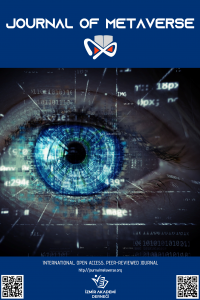Learner-Centered Analysis in Educational Metaverse Environments: Exploring Value Exchange Systems through Natural Interaction and Text Mining
Education 4.0, learner-centered, educational metaverse, blockchain, value exchange, text-mining
Learner-Centered Analysis in Educational Metaverse Environments: Exploring Value Exchange Systems through Natural Interaction and Text Mining
Education 4.0, learner-centered, educational metaverse, blockchain, value exchange, text-mining,
___
- S. Mystakidis, “Metaverse,” Encyclopedia, vol. 2, no. 1, pp. 486–497, 2022.
- Y.-C. Tsai, “The value chain of education metaverse,” arXiv preprint arXiv:2211.05833, 2022.
- K. D. Setiawan, A. Anthony et al., “The essential factor of metaverse for business based on 7 layers of metaverse–systematic literature review,” in 2022 International Conference on Information Management and Technology (ICIMTech). IEEE, 2022, pp. 687–692.
- R. Ferreira-Mello, M. Andre´, A. Pinheiro, E. Costa, and C. Romero, “Text mining in education,” Wiley Interdisciplinary Reviews: Data Mining and Knowledge Discovery, vol. 9, no. 6, p. e1332, 2019.
- M. Hernandez-de Menendez, C. A. Escobar D´ıaz, and R. Morales- Menendez, “Engineering education for smart 4.0 technology: a review,” International Journal on Interactive Design and Manufacturing (IJI- DeM), vol. 14, pp. 789–803, 2020.
- D. A. Norman and J. C. Spohrer, “Learner-centered education,” Com- munications of the ACM, vol. 39, no. 4, pp. 24–27, 1996.
- P. Caratozzolo, A. Friesel, P. J. Randewijk, and D. Navarro-Duran, “Virtual globalization: An experience for engineering students in the education 4.0 framework,” in 2021 ASEE Virtual Annual Conference Content Access, 2021.
- R. M. Moate and J. A. Cox, “Learner-centered pedagogy: Considerations for application in a didactic course.” Professional Counselor, vol. 5, no. 3, pp. 379–389, 2015.
- E. Oliveira, P. G. de Barba, and L. Corrin, “Enabling adaptive, person- alised and context-aware interaction in a smart learning environment: Piloting the icollab system,” Australasian Journal of Educational Tech- nology, vol. 37, no. 2, pp. 1–23, 2021.
- M. Cukurova, M. Giannakos, and R. Martinez-Maldonado, “The promise and challenges of multimodal learning analytics,” British Journal of Educational Technology, vol. 51, no. 5, pp. 1441–1449, 2020.
- Y.-C. Tsai, J.-Y. Huang, and D.-R. Chiou, “Empowering young learners to explore blockchain with user-friendly tools: A method using google blockly and nfts,” arXiv preprint arXiv:2303.09847, 2023.
- S. Periyasami and A. P. Periyasamy, “Metaverse as future promising plat- form business model: Case study on fashion value chain,” Businesses, vol. 2, no. 4, pp. 527–545, 2022.
- E. AbuKhousa, M. S. El-Tahawy, and Y. Atif, “Envisioning architecture of metaverse intensive learning experience (milex): Career readiness in the 21st century and collective intelligence development scenario,” Future Internet, vol. 15, no. 2, p. 53, 2023.
- J. Han, G. Liu, and Y. Gao, “Learners in the metaverse: A systematic review on the use of roblox in learning,” Education Sciences, vol. 13, no. 3, p. 296, 2023.
- M. Ersoy and R. Gu¨rfidan, “Blockchain-based asset storage and service mechanism to metaverse universe: Metarepo,” Transactions on Emerging Telecommunications Technologies, vol. 34, no. 1, p. e4658, 2023.
- L. I. Gonza´lez-Pe´rez and M. S. Ram´ırez-Montoya, “Components of education 4.0 in 21st century skills frameworks: systematic review,” Sustainability, vol. 14, no. 3, p. 1493, 2022.
- W. Suh and S. Ahn, “Utilizing the metaverse for learner-centered con- structivist education in the post-pandemic era: an analysis of elementary school students,” Journal of Intelligence, vol. 10, no. 1, p. 17, 2022.
- T. Huk, “From education 1.0 to education 4.0-challenges for the con- temporary school,” The New Educational Review, vol. 66, pp. 36–46, 2021.
- M. Zhu, C. J. Bonk, and M. Y. Doo, “Self-directed learning in moocs: Exploring the relationships among motivation, self-monitoring, and self-management,” Educational Technology Research and Development, vol. 68, pp. 2073–2093, 2020.
- E. Rabin, Y. M. Kalman, and M. Kalz, “An empirical investigation of the antecedents of learner-centered outcome measures in moocs,” International Journal of Educational Technology in Higher Education, vol. 16, no. 1, pp. 1–20, 2019.
- C. Romero and S. Ventura, “Educational data mining and learning analytics: An updated survey,” Wiley Interdisciplinary Reviews: Data Mining and Knowledge Discovery, vol. 10, no. 3, p. e1355, 2020.
- P. Blikstein and M. Worsley, “Multimodal learning analytics and educa- tion data mining: Using computational technologies to measure complex learning tasks,” Journal of Learning Analytics, vol. 3, no. 2, pp. 220– 238, 2016.
- Y.-C. Tsai, “Empowering learner-centered instruction: Integrating chat- gpt python api and tinker learning for enhanced creativity and problem- solving skills,” arXiv preprint arXiv:2305.00821, 2023.
- E. Johnston, G. Olivas, P. Steele, C. Smith, and L. Bailey, “Exploring pedagogical foundations of existing virtual reality educational applica- tions: A content analysis study,” Journal of Educational Technology Systems, vol. 46, no. 4, pp. 414–439, 2018.
- H. Lohman, Y. Griffiths, B. M. Coppard, and L. Cota, “The power of book discussion groups in intergenerational learning,” Educational Gerontology, vol. 29, no. 2, pp. 103–115, 2003.
- L. S. Davis, S. A. Johns, and J. Aggarwal, “Texture analysis using generalized co-occurrence matrices,” IEEE Transactions on pattern analysis and machine intelligence, no. 3, pp. 251–259, 1979.
- Yayın Aralığı: Yılda 2 Sayı
- Başlangıç: 2021
- Yayıncı: İzmir Akademi Derneği
Path To Gain Functional Transparency In Artificial Intelligence With Meaningful Explainability
Md. Tanzıb HOSAİN, Mehedi Hasan ANİK, Sadman RAFİ, Rana TABASSUM, Khaleque INSİA, Md. Mehrab SIDDIKY
Towards an Ethics for the Healthcare Metaverse
Max TRETTER, David SAMHAMMER, Tabea OTT, Peter DABROCK
Architecting the Future: A Model for Enterprise Integration in the Metaverse
Amirmohammad NATEGHİ, Maedeh MOSHARRAF
A Bibliometric Analysis: Metaverse in Education Concept
The Impact of Metaverse on Work Life: A Delphi Study
Muzaffer Can ATAK, Esma ERGÜNER ÖZKOÇ
Cheng XU, Rui ZHONG, Chenxi Lİ, Xuyou YAN
Virtual Reality Skateboard Extending Metaverse
Kanishka KATARİA, J CHANDANA, Athira RAGHUMADHAVAN, Komal GANDHİ, Kartik RAJA, Shilpa GİTE
Stelios IOANNIDIS, Alexios Patapios KONTIS
Metaverse: Security and Privacy Concerns
Ruoyu ZHAO, Yushu ZHANG, Youwen ZHU, Rushi LAN, Zhongyun HUA
